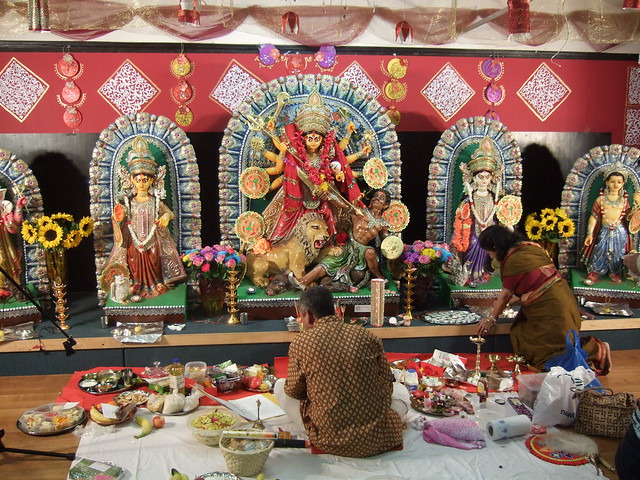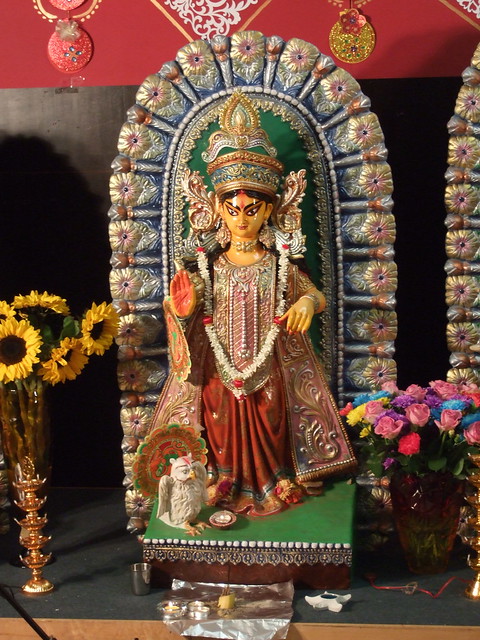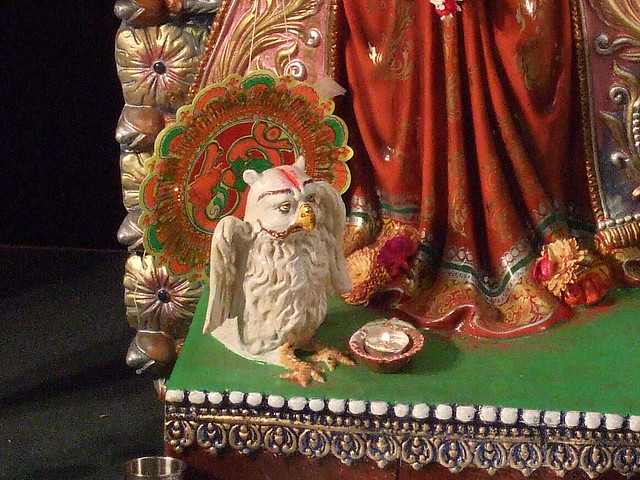Yesterday, I went to the Durga Puja. My friend and Hindi teacher who is from Delhi had kindly invited me along. I arrived to find the hall of Hills Road Sixth Form College transformed into a pandal.
What is a Durga Puja? Well, it's an Indian Hindu religious festival that celebrates the Goddess Durga. To be more precise, it's the biggest festival in Eastern India and particularly associated with Bengal. The festival follows the moon calendar so it's on a slightly different date in September or October every year.
So why is it in Cambridge? In 2001, around 5,000 people originally from India or Bangladesh lived in Cambridgeshire. I would say that around 200 people were at the Durga Puja, mostly Indians but also some others, like me. And, as I myself know from my own expat experience, expatriates are often keen to organise important festivals, if not for religious reasons then for cultural ones. I asked one attendant at today's celebration if he would go to the Durga Puja back home in Calcutta, and he said probably not.
So why write about this in relation to art? Because five statues of divine beings are part of the Durga celebrations: Durga and her children Ganesh, Lakshmi, Saraswati and Kartikeya.
In the centre stands Durga herself. She is seen fighting the buffalo demon Mahishasura (you can see parts of trampled buffalo beneath Durga's feet). Her steed is a lion. Her multiple arms hold symbolic weapons and tools: a discus (or chakra), a trident, a sword, a conch shell, a bow and arrow, a lotus flower, and a mace. More on these objects in Bridget's yoga blog.
Durga is flanked by her four children, from left to right: her son Ganesh (with a baby's body and an elephant's head); her daughter Lakshmi (with her attribute of wisdom, the white owl); her other daughter Saraswati (with lute and swan, the symbol of discrimination between right and wrong); and her other son Kartikeya.
All the gods, as befits gods, face outwards in hieratic frontal postures. Their eyes stare straight ahead. They are iconic in the religious sense but they are also iconic in the sense that they are not narrative.
Art historians have discussed profile and frontal views with respect to Christian icons (Meyer Schapiro, Boris A. Uspenksi). They argue that frontality is reserved for the Virgin Mary, Christ and the saints. Lesser figures are presented in profile, for example, supplicants, donors, demons or insignificant persons. We as devotees face the holy icon and pray to it. The icon exists in an eternal realm beyond time so it does not participate in any narrative. It faces outwards forever.
I don't know to what extent these findings can be translated to the context of Indian art. Certainly, Durga's children stand in hieratic frontality. Durga also stares outward while at the same time being engaged in fierce action. However, the slaying of the demon is not really presented as a story. Durga does not look at the demon; she expends no apparent effort; she is shown as eternally vanquishing evil.
 |
| Christ Pantokrator. 13th-C. mosaic icon, Hagia Sophia, Istanbul (Creative Commons license) |
I don't know to what extent these findings can be translated to the context of Indian art. Certainly, Durga's children stand in hieratic frontality. Durga also stares outward while at the same time being engaged in fierce action. However, the slaying of the demon is not really presented as a story. Durga does not look at the demon; she expends no apparent effort; she is shown as eternally vanquishing evil.
In Bengal, the statues are made of clay and the celebrations end with a ceremonial procession of the statues at the end of which they are sunk into the river (and effectively destroyed). A new set of statues is then made for the next year. In Cambridge, it would not do to parade five divine statues through town and throw them into the Cam (alas). So they are kept year after year.
So what do people do with these statues? I saw these statues 'at work', so to speak. They were not sitting in a museum, being 'Art' (unlike this Ganesha sculpture I saw at the Museum of Archaelogy & Anthropology in Cambridge).
But look: even though this little stone god was sitting high on a pedestal above the books in the museum gift store, somebody had left an offering on his leg. Somebody had turned the 'Art' back into the 'God'.
The statues at the Durga Puja were also, as it were, 'live'. People interacted with them. On the ground before them were offerings of fruit (which were later distributed to all of us: a lovely gesture of welcome and inclusion). The incense smoke was so intense that at one point everybody had to troop out into the yard because a fire alarm had gone off.
At 1.30, a priest intoned a prayer to Durga into a microphone. Most people gathered before the five statues at the front of the hall. It was quite a throng, all standing facing the deities and repeating the Sanskrit words after the priest. Everybody was in gorgeous festival finery: green + red, mauve + bronze, rose + grey and hot pink saris, embroidered tunics and all manner of kurtas. One little girl ran around in what looked like a satin ball gown. :-)
This was the 11th Durga Puja in Cambridge, organised by the Indian Cultural Society.
Have you been at a religious festival recently and seen works of art that are also cult objects? Or once were?
Sources:
Durga Puja in Calcutta: The best pandals.
Meyer Schapiro's essay 'Frontal and Profile as Symbolic Forms'
Meyer Schapiro's essay 'Frontal and Profile as Symbolic Forms'
is discussed in Chris Miller's blog.
Some of Boris Uspenski's The Semiotics of the Russian Icon is on-line via google books.
Permalink: http://artincambridge.blogspot.com/2012/10/statues-of-hindu-gods-durga-puja.html
Permalink: http://artincambridge.blogspot.com/2012/10/statues-of-hindu-gods-durga-puja.html
.










Looks like you enjoyed the experience of Durga puja! If you ever have a chance to visit it on a trip to India, you should...especially during the arti (when they sing songs to the deities). It's incredibly energizing ... There are traditional drummers, conch blowers and bells...and a lot of smoke!! It's a very different - and a much more fun experience - than most other Hindu artis.
ReplyDeleteOh, yes, I totally enjoyed it! I would love to visit a Durga Puja in India. In fact, I would love to go back to India full stop. I went for only 3 days a year ago (to Delhi) and was absolutely entranced. I have basic Hindi but it could do with a lot of brushing up... :-) What town would you recommend for a Durga Puja?
Deletethis is a really great information about the hindu gods
ReplyDeleteThanks, Shahid! It was great fun and super interesting to research, and I loved visiting the Durga Puja.
Delete